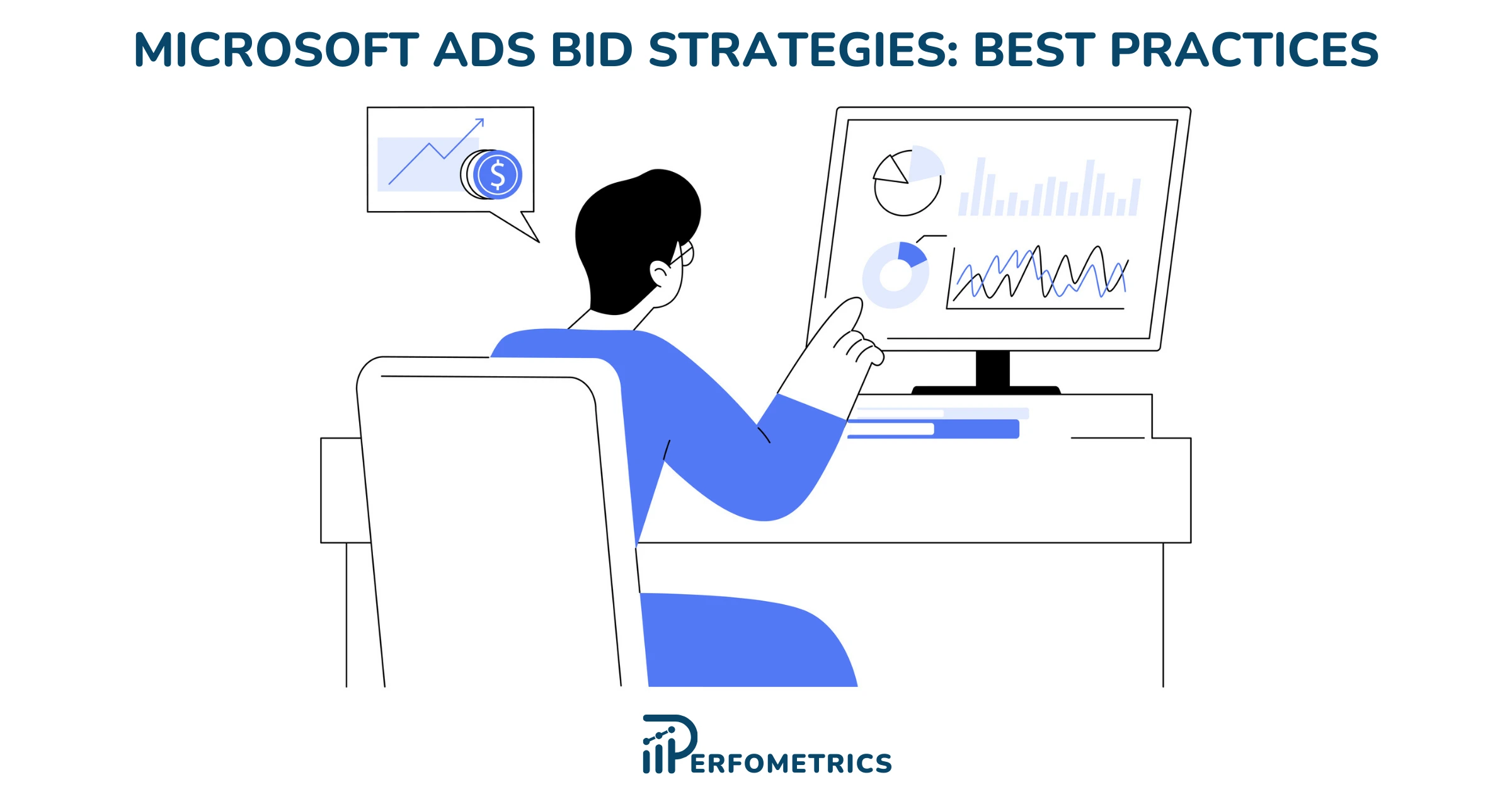Best Practices For Using Bid Strategies in Microsoft Ads

To achieve success with Microsoft Ads bidding strategies, it’s crucial to align your approach with your business goals, understand the nuances of each strategy, and continuously optimize your campaigns.
Here are some best practices for using bid strategies in Microsoft Ads:
- Understand Your Campaign Goals: Before selecting a bidding strategy, clearly define what success looks like for your campaign type in Microsoft Ads. Is it brand awareness, lead generation, sales, or a specific return on investment? For example, if your goal is to increase website traffic, ‘Maximize Clicks’ might be your go-to strategy. Conversely, if you’re looking to drive sales, ‘Cost per Sale (CPS)’ or ‘Target ROAS’ could be more appropriate.
- Set a Realistic Budget: Begin by setting a budget in Microsoft Ads that reflects your business size, industry standards, and campaign goals. If you’re a small business, you might start with a modest budget to test the waters. For example, allocate a daily budget that allows for enough clicks or impressions to gather meaningful data without exhausting your resources too quickly.
- Allocate Budget Based on Performance: Review your campaigns regularly to identify which ones are performing best in terms of your key performance indicators (KPIs). Shift more of your budget to high-performing campaigns. For instance, if you notice that your ‘Maximize Conversions’ campaign is yielding a high return on ad spend (ROAS), it would be wise to funnel more budget into that campaign.
- Start with Manual Bidding: If you’re new to Microsoft Ads, begin with Enhanced CPC to understand how different bids impact your ad performance. This hands-on approach gives you granular control and insights into the auction dynamics. For instance, if you notice that certain keywords drive more conversions, you can manually increase bids on those keywords to capitalize on their performance.
- Use Historical Data: Leverage historical data to inform your bidding decisions. If you’ve run campaigns in the past, analyze which keywords, ads, and bid amounts yielded the best results. Suppose you’ve had a high success rate with a ‘Target CPA’ of $20 in the past; use this as a benchmark when setting up new campaigns.
- Implement Automated Bidding Gradually: Once you have enough data, experiment with automated bidding strategies. Start with a portion of your budget or select campaigns to test strategies like ‘Enhanced CPC’ or ‘Maximize Conversions’. Monitor these closely to ensure they meet your performance criteria before fully committing.
- Optimize for Quality Score: A high Quality Score can reduce your costs and improve ad placement. To enhance your Quality Score, focus on:
- Relevant Keywords: Choose keywords closely related to your ads.
- Ad Copy Relevance: Ensure your ad copy speaks directly to the search query.
- Landing Page Experience: Create landing pages that provide value and a good user experience.
- Adjust for Seasonality and Trends: Adjust your bids based on seasonal trends and market changes. If you’re selling swimwear, you might increase your bids in the lead-up to summer. Use tools like Google Trends to anticipate when interest in your products or services is likely to peak.
- Regularly Review and Adjust: Continuously review campaign performance, and budget expenditures and make adjustments. If you’re using ‘Target ROAS’, and you notice that the return is consistently below your target, you may need to adjust your bids, and your targeting settings or review the conversion value you’re attributing to your products.
- Test and Learn: Always be testing. Try A/B testing with different ad copies or landing pages to see which performs better. For instance, you could run two versions of an ad with different headlines to see which yields a higher click-through rate.
- Stay Updated: The digital advertising landscape is always evolving. Stay informed about the latest features and best practices in Microsoft Ads. Join forums, attend webinars, and read industry blogs to keep your knowledge current.
Outside of best practices, before making any change to your campaigns or strategies, also considers the pros and cons of the bid strategies in Microsoft Ads.
Best Practices for Cost per Completed View (CPCV) Bidding in Microsoft Ads
When you’re aiming to ensure your video content doesn’t just start but finishes strong with your audience, CPCV is your go-to strategy. It’s about getting value for each view, making sure your message is seen and heard in its entirety.
To maximize your CPCV bid strategy in Microsoft Ads, consider the following best practices:
- Produce High-Quality Videos: Invest in creating engaging and high-quality video content that viewers will want to watch through to the end.
- Define Clear Objectives: Be clear about what action you want viewers to take after watching the video.
- Optimize for Mobile: Ensure your video content is optimized for mobile viewing, where a significant portion of the content is consumed.
- Use Captivating Thumbnails: Attract viewers with compelling thumbnails and titles.
- Test Different Video Lengths: Experiment with different video durations to find the sweet spot for viewer engagement.
- Analyze Viewer Drop-Off Points: Use analytics to understand where viewers are dropping off and adjust your content accordingly.
- Incorporate Clear Calls-to-Action: Make sure your video has a clear call-to-action that encourages viewers to engage further with your brand.
Best Practices for Cost per Thousand Impressions (CPM) Bidding in Microsoft Ads
If brand visibility is your beacon, then CPM shines the light. This strategy is all about impressions, ensuring your ad gets a thousand eyes on it, making it perfect for boosting your brand’s presence.
To maximize your CPM bid strategy in Microsoft Ads, consider the following best practices:
- Target Appropriately: Use demographic and geographic targeting to ensure your ads are seen by your desired audience.
- Design Impactful Creatives: Since the goal is impressions, make sure your ad creatives are visually appealing and memorable.
- Monitor Frequency: Keep an eye on how often individuals see your ad to avoid ad fatigue.
- Test and Iterate: Run A/B tests with different ad designs and messaging to see what resonates best with your audience.
- Analyze and Adjust: Regularly review campaign analytics to adjust your strategy and improve performance.
- Leverage Retargeting: Combine CPM with retargeting strategies to increase brand recall among those who have previously interacted with your brand.
- Balance with Other Strategies: Use CPM as part of a broader marketing strategy that includes other bidding methods aligned with different campaign goals.
Best Practices for Cost per Sale (CPS) Bidding in Microsoft Ads
CPS is the strategy where the endgame is a transaction. You’re not just casting nets; you’re reeling in the catch. It’s about aligning your bids with the ultimate goal of sales, ensuring each ad dollar is spent with a return in mind.
To maximize your CPS bid strategy in Microsoft Ads, consider the following best practices:
- Optimize Your Landing Pages: Ensure the path to purchase is as smooth as possible to increase conversion rates.
- Use Precise Targeting: Target audiences that have shown interest in similar products or have a history of online purchases.
- Track Everything: Implement robust tracking to accurately attribute sales to the right ads.
- Adjust Bids Based on Value: Set higher bids for products with higher margins or lifetime value.
- Test and Learn: Continuously test different ad creatives and landing pages to find the best performers.
- Understand Your Customer Journey: Be aware of how customers interact with your business online before making a purchase.
- Manage and Monitor Regularly: Regularly review campaign performance to make necessary adjustments.
Best Practices for Enhanced Cost per Click (eCPC) Bidding in Microsoft Ads
Enhanced CPC strikes a balance between manual and automated bidding, giving you the control to steer your campaign while allowing for automated adjustments to maximize conversions.
To maximize your eCPS bid strategy in Microsoft Ads, consider the following best practices:
- Ensure Accurate Conversion Tracking: eCPC relies on conversion data, so accurate tracking is essential.
- Start with a Solid Base Bid: Set your manual bids based on valuable conversion data before enabling eCPC.
- Monitor Performance Closely: Keep an eye on your campaigns to ensure eCPC is performing as expected.
- Use in Conjunction with Other Features: Combine eCPC with ad scheduling and demographic targeting for better results.
- Be Patient: Allow the algorithm time to learn and optimize after enabling eCPC.
- Regularly Update Conversion Values: Make sure the values assigned to conversions reflect their true worth to your business.
- Maintain a Healthy Budget: Ensure your budget can accommodate the potential increase in CPC due to bid adjustments.
Best Practices for Manual Cost per Click (CPC) Bidding in Microsoft Ads
Manual CPC puts you at the helm, giving you complete control over your bids. It’s ideal for when you want to navigate your campaign with precision, adjusting your bids based on the changing tides of campaign performance.
To maximize your Manual CPC bid strategy in Microsoft Ads, consider the following best practices:
- Regular Monitoring: Check your account often to make adjustments as needed.
- Keyword Performance Analysis: Bid more on keywords that convert and less on those that don’t.
- Use Bid Modifiers: Adjust bids for different devices, locations, and times of day.
- Set Competitive Bids: Ensure your bids are competitive enough to gain ad placement.
- Leverage Analytics: Use analytics to inform your bidding decisions.
- Consider Quality Score: A higher Quality Score can lead to lower costs and better ad positions.
- Stay Informed on Market Trends: Adjust your bids according to market and competition changes.
Best Practices for Manual CPM Bidding in Microsoft Ads
For those who prefer to chart their own course, Manual CPM allows you to set the cost for a thousand impressions, giving you control over brand exposure and the flexibility to adjust as you see fit.
To maximize your Manual CPM bid strategy in Microsoft Ads, follow these best practices:
- Target the Right Audience: Use demographic and geographic targeting to ensure your ads are seen by your desired audience.
- Monitor Ad Performance: Keep an eye on how your ads perform in terms of brand engagement and adjust bids accordingly.
- Set Realistic Budgets: Understand the value of impressions for your brand and set budgets that reflect this value.
- Use High-Quality Creatives: Since the goal is impressions, make sure your ad creatives are designed to capture attention.
- Balance Frequency and Reach: Aim for a balance between how often your ad is seen and the size of the audience it reaches.
- Test Different Ad Placements: Experiment with different ad placements to find the most cost-effective options for visibility.
- Review and Adjust Regularly: Regularly review campaign metrics to ensure that your Manual CPM bids are competitive and delivering the desired results.
Best Practices for Manual CPV (Cost Per View) in Microsoft Ads
When your content is king, Manual CPV ensures it gets the royal treatment. This strategy lets you decide the worth of a view, giving you control over your video content’s performance.
To maximize your Manual CPV bid strategy in Microsoft Ads, follow these best practices:
- Create Compelling Content: Your video content should be engaging and relevant to your target audience.
- Define Clear Goals: Know what you want to achieve with your video ad, whether it’s brand awareness, product introduction, or storytelling.
- Use Targeting Options: Take advantage of Microsoft Ads’ targeting options to reach the right audience.
- Test and Optimize: Test different videos and creative elements to see what resonates best with your audience.
- Monitor View Rates: Keep an eye on how many people are watching your video and for how long.
- Adjust Bids Accordingly: If you notice high engagement, consider increasing your bid to gain more visibility.
- Analyze and Refine: Use analytics to understand performance and refine your strategy for better results.
Best Practices for Target Impression Share Bidding in Microsoft Ads
Target Impression Share is about making a splash, aiming to get your ad in front of a percentage of searches. It’s ideal for increasing visibility and dominating the search landscape.
To maximize your Target Impression Share bid strategy in Microsoft Ads, follow these best practices:
- Set Realistic Impression Share Targets: Choose a target that is attainable and aligns with your overall campaign objectives.
- Use a Competitive Budget: Ensure your budget can support the higher bids required for top-of-page positions.
- Monitor Performance Closely: Keep an eye on your campaign’s performance and adjust your impression share target as needed.
- Combine with Quality Content: Ensure your ads and landing pages are high-quality to make the most of the increased visibility.
- Implement Bid Caps: Set a maximum bid to prevent spending too much per click.
- Regularly Review Search Term Reports: Analyze performance data to refine your strategy and improve ad relevance.
- Balance with Other Strategies: Consider using Target Impression Share in conjunction with other bidding strategies for different parts of your campaign.
Best Practices for Maximize Clicks Bidding in Microsoft Ads
Maximize Clicks is your autopilot, aiming to get as many visitors to your site as possible within your budget. It’s perfect for when you want to boost traffic and let the algorithm find the best opportunities.
To maximize your Maximize Clicks bid strategy in Microsoft Ads, follow these best practices:
- Set a Clear Budget: Define a budget that reflects your willingness to spend on gaining clicks.
- Monitor Campaigns Regularly: Keep an eye on performance to ensure clicks are converting to desired actions.
- Implement Conversion Tracking: While Maximize Clicks focuses on traffic, tracking conversions can help you understand the quality of clicks.
- Use Negative Keywords: To avoid irrelevant clicks, regularly update your negative keyword list.
- Set a Bid Limit: If possible, set a maximum bid to prevent the system from placing unexpectedly high bids.
- Review Search Term Reports: Analyze which search terms are driving traffic and adjust your strategy accordingly.
- Balance with Other Strategies: Consider using Maximize Clicks in tandem with other strategies for different campaign goals.
Best Practices for Maximize Conversions Bidding in Microsoft Ads
If you’re focused on results, Maximize Conversions is the strategy that targets the outcome. It uses advanced algorithms to get you the most conversions for your budget, optimizing your bids for you.
To maximize your Maximize Conversions bid strategy in Microsoft Ads, follow these best practices:
- Ensure Accurate Conversion Tracking: Set up conversion tracking properly to provide the algorithm with the right data.
- Set a Realistic Budget: Your budget should reflect the value you place on conversions.
- Review and Adjust: Regularly review campaign performance and adjust your budget and strategy as needed.
- Understand Your Conversion Value: Know how much each conversion is worth to your business to evaluate the strategy’s effectiveness.
- Use in Conjunction with Other Strategies: Consider using Maximize Conversions for some campaigns while employing other strategies for different objectives.
- Exclude Poor-Performing Keywords: Regularly prune keywords that spend without converting.
- Test and Learn: Experiment with different campaign settings and learn from the performance data.
Best Practices for Target Cost per Action (tCPA) Bidding in Microsoft Ads
Target CPA is about cost efficiency, setting a target for the cost per acquisition that makes sense for your business and letting the system optimize towards that goal.
To maximize your Target Cost per Action bid strategy in Microsoft Ads, follow these best practices:
- Establish Clear Conversion Tracking: Ensure your conversion tracking is accurately set up to inform the Target CPA algorithm.
- Set a Realistic Target CPA: Determine a CPA that reflects the value of a conversion to your business and is attainable based on historical data.
- Monitor and Adjust Bids: Regularly review performance data and adjust your target CPA as necessary.
- Consider Seasonality and Market Changes: Adjust your CPA targets based on seasonal trends and market fluctuations.
- Use with Sufficient Conversion Data: Implement Target CPA for campaigns with a solid history of conversions for best results.
- Balance Volume and Cost: Find a CPA that allows for a good balance between the volume of conversions and the cost per conversion.
- Combine Strategies When Appropriate: Use Target CPA in conjunction with other strategies for different parts of your campaign to meet various objectives.
By following these best practices, advertisers can effectively use Target CPA to meet their conversion goals while maintaining control over their acquisition costs on Microsoft Ads.
Best Practices for Target Return on Ad Spend (tROAS) Bidding in Microsoft Ads
Target ROAS focuses on the return, ensuring that you’re not just spending but making money from your ads. It’s about the balance between spend and revenue, aiming for the sweet spot of profitability.
To maximize your Target Cost per Action bid strategy in Microsoft Ads, follow these best practices:
- Track Revenue Accurately: Ensure that you’re tracking the revenue from conversions accurately.
- Set Attainable ROAS Targets: Start with a realistic ROAS target based on historical performance.
- Review Performance Regularly: Monitor campaign performance and adjust your ROAS targets and strategies accordingly.
- Understand Your Margins: Know the margins of your products to set a ROAS that ensures profitability.
- Allow for Learning: Give the algorithm time to learn and optimize before making significant changes.
- Balance ROAS with Overall Goals: Ensure your ROAS targets align with broader business objectives.
- Test and Refine: Continuously test different targets and strategies to find the optimal setup for your campaigns.
Best Practices for Portfolio Bidding Strategies in Microsoft Ads
Portfolio Bid Strategies are your strategic arsenal, designed to optimize bids across multiple campaigns. Think of it as your collective bargaining chip, where you can leverage the collective performance data of your campaigns to make informed bidding decisions.
To maximize your Portfolio bid strategy in Microsoft Ads, follow these best practices:
- Unified Campaign Goals: Ensure that all campaigns within the portfolio share similar performance goals.
- Sufficient Data: Implement portfolio bidding on campaigns with enough historical data for accurate optimization.
- Regular Monitoring: Keep an eye on performance trends and adjust your strategy as needed.
- Understand the Algorithms: Familiarize yourself with how portfolio bidding algorithms make decisions.
- Balance Automation with Oversight: Use portfolio bidding to automate where possible, but maintain oversight to ensure performance aligns with business objectives.
- Test and Iterate: Continuously test different settings within your portfolio strategy to find the most effective configurations.
- Stay Informed: Keep up with updates and best practices from Microsoft Ads to ensure you’re using portfolio bidding strategies effectively.
Our Final Thoughts
Your bid strategy in Microsoft Ads is your compass. Whether you’re looking to make waves with CPM or navigate towards profitable efforts with CPS, the key is to align your strategy with your business goals.
To learn about each of the bidding strategies, check the pros and cons of bid strategies in Microsoft Ads. The digital seas are ever-changing, so stay vigilant, adjust your sails as needed, and keep your campaigns optimized for the journey ahead.



